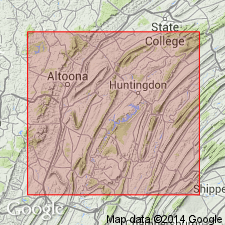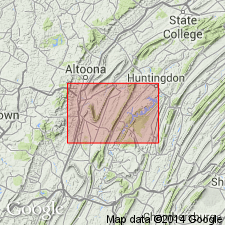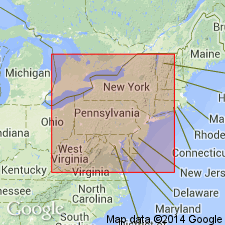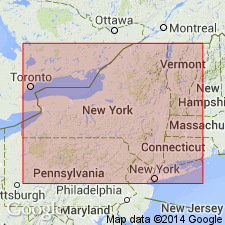
- Usage in publication:
-
- Larke dolomite
- Modifications:
-
- Named
- Dominant lithology:
-
- Dolomite
- Limestone
- AAPG geologic province:
-
- Appalachian basin
Summary:
Named the Larke dolomite for Larke, Blair Co., central PA. Consists of thick-bedded, coarse, steely blue limestone [dolomite]. Thickness is 250 feet. Overlies the Mines dolomite and unconformably underlies the Beekmantown group. The Larke is of Early Ordovician age.
Source: GNU records (USGS DDS-6; Reston GNULEX).

- Usage in publication:
-
- Larke dolomite*
- Modifications:
-
- Revised
- AAPG geologic province:
-
- Appalachian basin
Summary:
Revised the Larke dolomite as a part of the Beekmantown group in central PA. Consists of 250 feet of thick-bedded dolomite. Overlies Mines dolomite and underlies Nittany dolomite, both of Beekmantown group.
Source: GNU records (USGS DDS-6; Reston GNULEX).

- Usage in publication:
-
- Larke Formation
- Modifications:
-
- Areal extent
- Revised
- AAPG geologic province:
-
- Appalachian basin
Summary:
Revised the Larke to the Larke Formation and geographically extended it to northern WV. Unit correlates with the Stonehenge Limestone to the south.
Source: GNU records (USGS DDS-6; Reston GNULEX).

- Usage in publication:
-
- Larke Formation
- Modifications:
-
- Areal extent
- AAPG geologic province:
-
- Appalachian basin
Summary:
Geographically extended the Larke Formation to NY.
Source: GNU records (USGS DDS-6; Reston GNULEX).
For more information, please contact Nancy Stamm, Geologic Names Committee Secretary.
Asterisk (*) indicates published by U.S. Geological Survey authors.
"No current usage" (†) implies that a name has been abandoned or has fallen into disuse. Former usage and, if known, replacement name given in parentheses ( ).
Slash (/) indicates name conflicts with nomenclatural guidelines (CSN, 1933; ACSN, 1961, 1970; NACSN, 1983, 2005, 2021). May be explained within brackets ([ ]).

